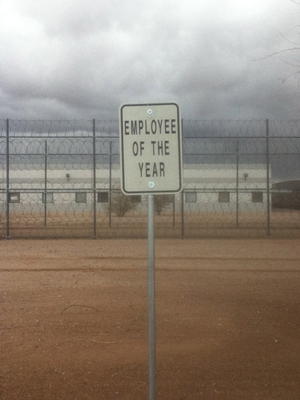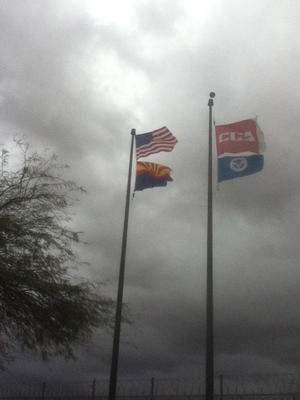On April 28, several women returned to their pod, or unit, in the immigration detention center in Eloy, Arizona after dinner. There they found the body of Elsa Guadalupe-Gonzalez, a fellow detainee who had taken her life. Elsa was 24 years old and from Guatemala.
In March, Elsa had crossed from Mexico into the United States without U.S. government authorization. When Border Patrol agents captured her, she told them that her life was in danger if she were to return to Guatemala, a country of intense poverty that has seen an upsurge of violence in recent years. Nonetheless, by making a claim of political asylum, she was entering the world of the U.S. immigration control complex where her life would also be in danger, where death is part of the equation.

Just last week, journalist Juan Carlos Frey vividly exposed a number of incidents of Border Patrol agents shooting into Mexico and killing people across the international divide. One case involved a man who was enjoying a picnic for his daughter’s birthday.
But more often than not, death at the hands of the immigration policing apparatus is not this direct. It comes as a result of the conditions created by the enforcement situation. The human remains of more than 6,000 people have been recovered in the southern borderlands of the United States since the mid-1990s, as they travel through treacherous areas to evade the border policing build-up, is one example. Another is when migrants take their own lives—as in Elsa’s case—driven to do so by a level of despair produced by a draconian detention and deportation system.
Just before lunch on the day of her death, Elsa was helping one of the women in her pod, Maggie (not her real name), with an art project. Maggie told a person who was working on her legal case, but who wishes to remain anonymous, that Elsa was smiling and joking around, giving no indication of what she was about to do. But when everyone else went to dinner, Elsa said that she was going to stay back. That happened all the time, so nobody thought anything of it. When they found her an hour later, she had hung herself with her shoelaces.
Two days later, a person named Jimmy (not his real name) was studying in the library, according to what he told a lawyer. A guard came and told Jimmy that a man in his pod named Jorge Garcia-Mejia was dead, and that, as a result, they had to put Jimmy in segregation, or “el hoyo” (the hole), where he would be questioned all afternoon.
“Please tell me you’re joking,” Jimmy told the guard. Jimmy knew Jorge well.
Meanwhile, Jimmy’s pod was on lockdown. The guards tried to stop other detainees from seeing into Jorge’s cell, though the men across the way could see that Jorge had also hung himself with shoelaces. According to a man held in the same unit, Jameson (not his real name), the guards told them not to look, or they would be thrown in the “hole.”
Jameson told a person close to the situation, but who wishes to remain anonymous, that “it took them an hour and a half to clean up the scene, then it was business as usual. They didn’t talk to us at all. They pulled him out, cleaned up, and went on with the day.”
When Jameson spoke those words it was almost a week after Jorge’s death. He was still terrorized by the suicide. He was rocking back and forth in his chair, and then sobbing, as he tried to discuss his own deportation case.
The same was true of Maggie, who was one of the first people to see Elsa’s body after the suicide. Normally she was calm, soft-spoken, and gracious. However, the day after the suicide she was obviously disturbed, rushed, and anxious. “This is scary, everybody is scared,” she told the person who was helping her with her legal case. “I need to know when I’m getting out.”
The suicides vividly expose, especially to everyone in the detention center, the most brutal aspects of an environment where individuals are cut off from your loved ones, families, and support systems. Once taken into custody, people are often sent to detention centers hundreds and even thousands of miles away. Through frequent transfers between detention centers and tight control of information, the present immigration detention system isolates individuals, often leaving them with a sense of hopelessness regarding their situation. When Maggie said, “I can see why they did it,” she was expressing a common sentiment. All the detainees can guess as to why Elsa and Jorge did what they did.
Immigration and Customs Enforcement (ICE), for its part, ran a press release for each incident where they wrote—in sparse, clinical language—that Elsa and Jorge had “passed away.” Beyond this, there is little official information about their cases.
What is known is that Elsa was waiting for a credible fear interview, which would start her asylum process, since she feared for her life in her own country. Credible fear interviews are supposed to happen within 10 days of filing a claim to asylum form. Elsa had been detained for more than a month. Sometimes the delays go on for months.

In the case of Jorge, the ICE press release announcing his death was entitled “ICE detainee under criminal investigation passes away at Eloy Detention Center.” Thus, in what was essentially his obituary, ICE put illegality and criminality front and center.
However, neither Jorge nor Elsa nor any of the more than 1,600 people crowded together in the detention center owned and run by the for-profit Corrections Corporation of America (CCA) were there as punishment for a crime. They were behind rows of razor wire just to ensure that they show up to immigration court.
Many in detention are fighting their threatened “removal” or deportation because they do not want to be separated from their families in the United States. Often they are parents who live in anguish at the prospect of losing the rights to their kids.
And Eloy, though one of the largest facilities in the country, is but a microcosm to the 34,000 beds that ICE is mandated to fill at any given time, in detention centers across the country. These facilities incarcerate more than 400,000 individuals a year.
In what The New York Times called a “rare growth industry” in the midst of the 2008 recession, immigration detention centers, like the CCA one in Eloy, earn on average $122 per person per day. Since 2005, CCA’s contracts with the Department of Homeland Security have more than doubled. In 2011, CCA brought in $208 million in federal contracts, with an ever-growing lobbying budget to, presumably, convince lawmakers to keep the detainees, like Elsa and Jorge, coming.
On May 7, in response to the suicides, American Civil Liberties Union-Arizona and the Detention Watch Network called for an end to mandatory detention of non-citizens. Alessandra Soler, ACLU-Arizona’s executive director said in a statement that “(T)hese tragedies point to long-standing concerns reported by people detained at the Eloy facility . . . including inadequate medical and mental health care and punitive conditions.”
After the suicides, some women detainees complained that they continue to hear the screams of the day when they found Elsa. Consequently, they have begun to receive sleeping pills. Meanwhile, the CCA has taken away many of the detainee’s shoe laces and replaced them with Velcro.
ICE says that its Health Service Corps is conducting a thorough assessment of the incidents. Also, the agency points to an inspection in July that found the Eloy facility to be “fully compliant” with the national standards on suicide prevention. In 2011, ICE put 42 people on suicide watch in Eloy. Suicide watch requires that a detainee go to the segregated area, the hole, where you are under 24 hour supervision, often with your clothing removed.
The person who was giving legal assistance to Jameson told me about her mixed feelings observing all the ICE officers, all the doctors, the guards, the ICE attorneys, and all the employees who claimed to be acting for the safety and well-being of those detained. She told me what Jameson said, as he talked shaking, when he showed her his Velcro shoes, “Do you think this will prevent anything? The television has an extension chord. The phones have long extension chord. If people want to kill themselves, they will find a way. People are depressed and sad in here.”
Jameson’s words speak to the broader immigration control complex, one that creates horrifying situations for people like Jorge and Elsa, in detention, in the desert, or in deportation. It is a complex of death that is slated to grow: According to of the proposals dominating discussion in relation to comprehensive immigration reform, it will have ever more money and resources, with little public debate at all.
Todd Miller has researched and written about U.S.-Mexican border issues for more than 10 years. He has worked on both sides of the border for BorderLinks in Tucson, Arizona, and Witness for Peace in Oaxaca, Mexico. He now writes on border and immigration issues for NACLA Report on the Americas and its blog “Border Wars,” among other places.

